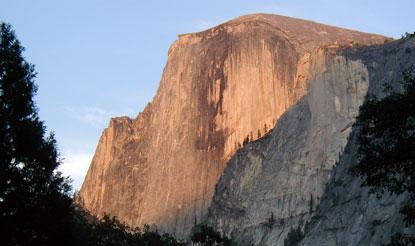Thousands of folks trek to the top of Half Dome in Yosemite National Park each summer. Their footprints have created a well-worn path up past Vernal and Nevada falls and onto the granite behemoth. Which begs the question: Does Half Dome offer visitors a wilderness experience?
How can it? The fact that so many folks make the hike arguably makes it impossible to enjoy a wilderness experience. Then, too, there's the use of cables provided by the National Park Service to make it possible to reach the summit with some measure of safety. In a true wilderness setting, you wouldn't find cables to help you along your way.
There's no question that the view from Half Dome is spectacular, but even it detracts from the wilderness experience when you gaze down upon the Yosemite Valley with its roads, lodgings, parking lots, and thousands of visitors.
To get others' opinions on this question, Steve Sergeant at the Wildebeat interviewed a handful of experts and hikers. You can find his audiocast on the matter here. Check it out.


 Support Essential Coverage of Essential Places
Support Essential Coverage of Essential Places







Comments
Simply put, NO.
A wilderness experience? You really have to ask?
Most of the National Parks I have been to have raped the wilderness with roads, lodgings, gas stations, parking lots, buses, trails, bridges, signs, scenic flights, large groups guided by corporate outfitters, etc..
There are a few of Our National Parks that I enjoy as a wilderness type of experience.
Unless these areas (or other areas in the NPS system for that matter) are within the boundaries of the Congressional designated Wilderness, they are not bound by the laws, prohibitions, and spirit of the 1964 Wilderness Act, nor do many of these areas have a wilderness management plan. Of course, the Wilderness Act didn't set forth use levels. One only has to visit several other wilderness areas across the NPS to realize during the summer, often we are really not alone in the wilderness.
As we saw with the 2006 NPS management policy fiasco, it is becoming increasingly easy for the NPS directorate to be handmaiden to the White House policy desires and not the Organic Act. Of course, one must only look at the rim of the Grand Canyon to see that development, tourism, and the NPS have always gone hand in hand.
I agree Anonymous (not verified), the fact is that the National Park Service manages most of our wilderness acreage.
I feel Our National Park Service, in almost the entire Wilderness areas that I visit has ignored or stepped around the Wilderness Act which defines an area of wilderness to mean an area of undeveloped Federal land retaining its primeval character and influence, without permanent improvements.
I see an over abundance of permanently developed improvements in over built trails, bridges, signs, scenic flights and in the commercialization of Wilderness as in large groups guided by corporate outfitters.
I would argue that the NPS has done much to promote wilderness. I know that even though the Great Smokies does not qualify as a wilderness area the NPS treats it as though it does have that designation. I feel certain that many other parks are doing similar acts. I live in Yosemite and have enjoyed the experience of hiking Half Dome, it is spectacular. That is probably why you don't get that widerness experience you feel entitled to. Venture only a little further to Clouds Rest and you will be rewarded. Or you may want to experience Half Dome by entering from somewhere other than Yosemite Valley. Spending the night at Little Yosemite Valley and hiking up in the wee hours of the morning will certainly allow for a less crowded experience. As long as National Parks are in spectacular places there will be crowds. Yosemite offers hundreds of miles of trails that are in designated wilderness areas where you will not be affected by crowds or over development. Its a difficult task to make available for the public enjoyment without having any impact. I think that the NPS does a pretty good job of finding a balance. Of course you can't please everyone.
I don't care what the legal definition of 'wilderness' is. For me, it's a place where I don't see any other human beings for long periods of time. With the crowds at Yosemite, even on so-called backcountry trails in the high country, that's impossible. (Doesn't matter if they're hiking alone, with a club or a 'corporate' outfitter).
I agree with much of what has been said here. And truthfully, on a personal level, I do question many management decisions of the NPS. However, a big problem we face, more than NPS management, is the expectations of visitors . Too many people just want to see animals from their cars, tour buses, etc. rather than expending any energy and actually experiencing anything.
Our park visitors, in many cases, aren't doing anything active, and expect to be catered to. Of course, this is not what the wilderness experience is about, but how can we shift these core attitudes?
I spent this past summer conducting recreation research in Alaska, you'd be surprised at my data. It's sad how people want to see these places on TV, but rarely want to expend any energy at all on the experience.
In my opinion, this is the root of the problem.
I believe this is a problem of our National Park Service; it has turned into government paid caterers.
"Oh Ranger, there is a bear in my woods.."
It is time the National Park Service stopped this nonsense and got back to preservation and education by not offering the couch, TV or tourist bus and urging folks to walk the Wilderness where expectations do not survive.